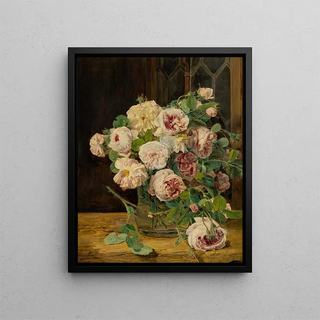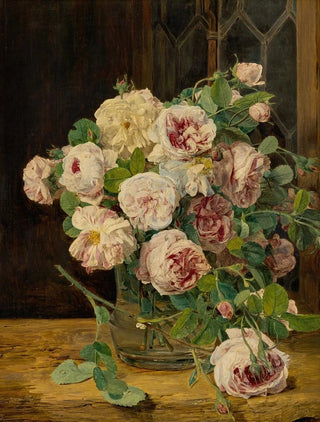Art print | Bouquet de roses à la fenêtre - Ferdinand Georg Waldmüller


View from behind

Frame (optional)
Art print Bouquet of roses at the window - Ferdinand Georg Waldmüller – Captivating introduction
In the vibrant universe of 19th-century art, the work "Bouquet of roses at the window" by Ferdinand Georg Waldmüller stands out for its charm and delicacy. This painting, which evokes the fleeting beauty of flowers, transports the viewer to a suspended moment where nature and interior meet gracefully. Through this piece, Waldmüller manages to capture the very essence of domestic life, while highlighting the splendor of roses, symbols of love and beauty. The artist invites us to contemplate this bouquet, not only as a simple floral representation but also as an invitation to reflect on the passage of time and the ephemeral.
Style and uniqueness of the work
Waldmüller's style is characterized by striking realism, where every detail is carefully observed and rendered with remarkable precision. In "Bouquet of roses at the window," he uses a delicate color palette, blending pastel tones and flashes of light, to bring the petals of the roses to life. The composition is skillfully orchestrated: the bouquet, placed at the window, seems to dialogue with the outside world, creating a link between interior and exterior. The natural light filtering through the glass adds a poetic dimension to the work, illuminating the roses with a soft, warm glow. Waldmüller thus manages to transform a simple bouquet into a lively scene, where each rose tells a story.
The artist and his influence
Ferdinand Georg Waldmüller, born in 1793 in Austria, is often regarded as one of the masters of Austrian realism. His career is marked by an unceasing quest for beauty in everyday life, which he captures with a unique sensitivity. Influenced by the Romantic movement, Waldmüller stands out for his ability to combine faithful representation of nature with an emotional approach, touching the hearts of his contemporaries. His works, often imbued with nostalgia, reflect an idealized vision of bourgeois life, while highlighting the beauty of simple moments. By painting bouquets of flowers, landscapes, and scenes of domestic life,

Matte finish

View from behind

Frame (optional)
Art print Bouquet of roses at the window - Ferdinand Georg Waldmüller – Captivating introduction
In the vibrant universe of 19th-century art, the work "Bouquet of roses at the window" by Ferdinand Georg Waldmüller stands out for its charm and delicacy. This painting, which evokes the fleeting beauty of flowers, transports the viewer to a suspended moment where nature and interior meet gracefully. Through this piece, Waldmüller manages to capture the very essence of domestic life, while highlighting the splendor of roses, symbols of love and beauty. The artist invites us to contemplate this bouquet, not only as a simple floral representation but also as an invitation to reflect on the passage of time and the ephemeral.
Style and uniqueness of the work
Waldmüller's style is characterized by striking realism, where every detail is carefully observed and rendered with remarkable precision. In "Bouquet of roses at the window," he uses a delicate color palette, blending pastel tones and flashes of light, to bring the petals of the roses to life. The composition is skillfully orchestrated: the bouquet, placed at the window, seems to dialogue with the outside world, creating a link between interior and exterior. The natural light filtering through the glass adds a poetic dimension to the work, illuminating the roses with a soft, warm glow. Waldmüller thus manages to transform a simple bouquet into a lively scene, where each rose tells a story.
The artist and his influence
Ferdinand Georg Waldmüller, born in 1793 in Austria, is often regarded as one of the masters of Austrian realism. His career is marked by an unceasing quest for beauty in everyday life, which he captures with a unique sensitivity. Influenced by the Romantic movement, Waldmüller stands out for his ability to combine faithful representation of nature with an emotional approach, touching the hearts of his contemporaries. His works, often imbued with nostalgia, reflect an idealized vision of bourgeois life, while highlighting the beauty of simple moments. By painting bouquets of flowers, landscapes, and scenes of domestic life,






